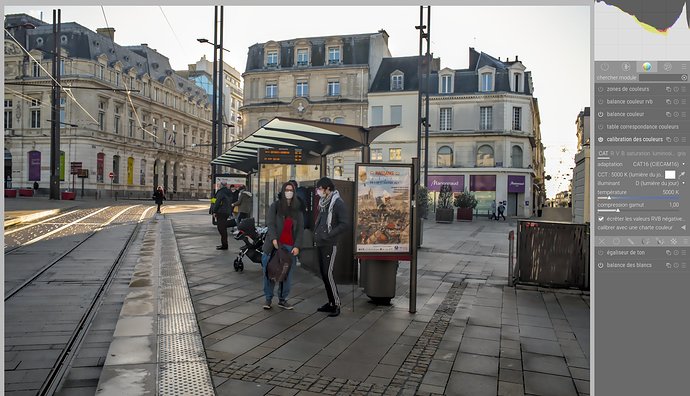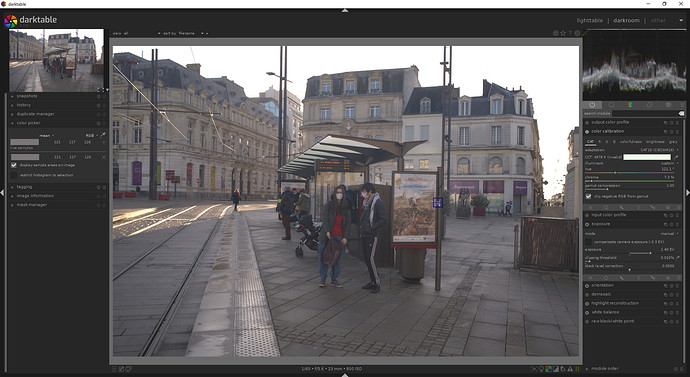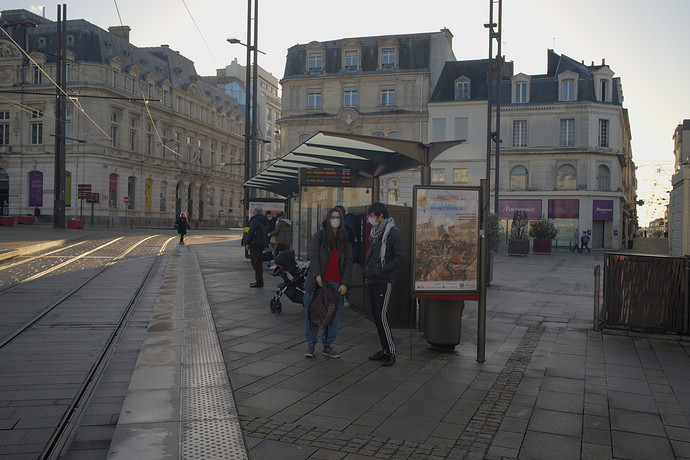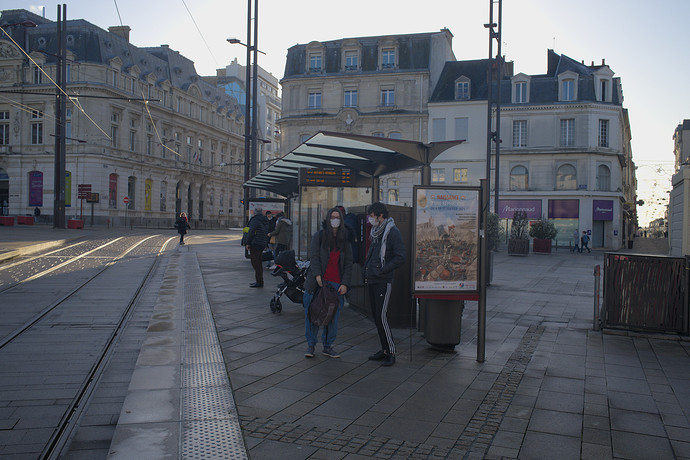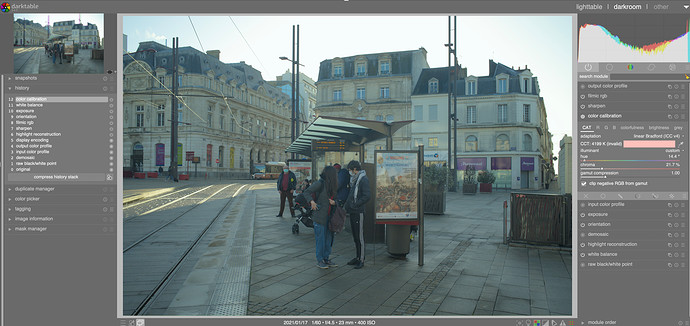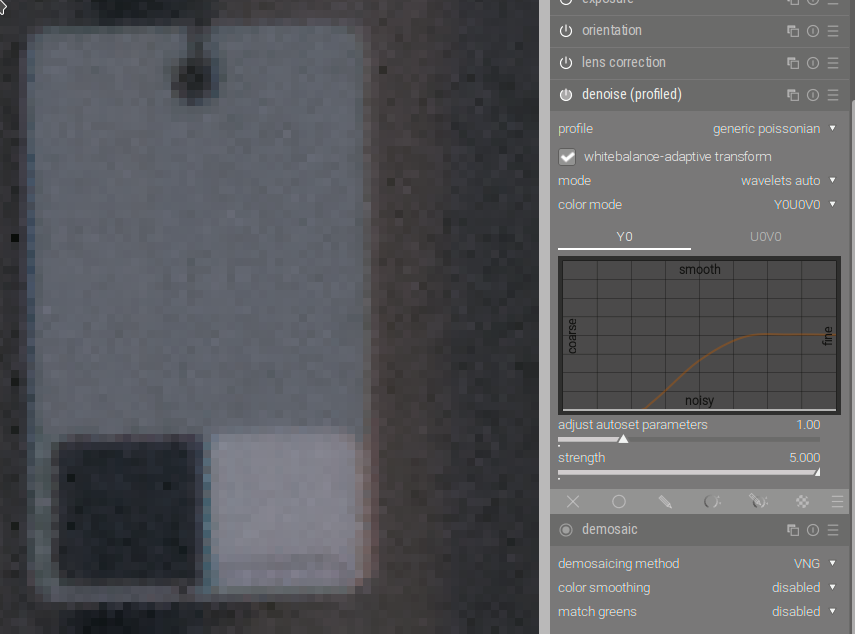Hello,
I have problems getting a good white balance with the new colour calibration module. I have a photo here using a neutral gray card (hanging on the post to the right). The colour is ok when colour calibration is off. When I switch it on, the picture goes very blue. If I pick the gray card, the picture takes a horrible greenish tinge. The only way I can get something acceptable is by using “detect from image surfaces”, but the grey card has no use then… Small detail, if I pick the surface of the grey card as a gray point and then read the area with a color picker, I get (54,48,47), not very grey.
I tried the image in capture one, the white balance seems fine if I pick the card and the rgb values are (150,150,150).
Thanks for any help,
NicolasFUJIFILM-X100V-2021-01-17-10h09min35s.raf.xmp (7.5 KB) FUJIFILM-X100V-2021-01-17-10h09min35s.raf (55.2 MB)
In color calibration module, by just adjusting tint to 5000 kelvins (by using your xmp) and I have what you want (same like without color calibration). By default, color picker set the tint to 4824 in that image, but you are free to increase or decrease tint on what you want).
See setting and image below:
And the xmp: FUJIFILM-X100V-2021-01-17-10h09min35s.raf.xmp (8.1 KB)
Hi, I have no issue with your image. With or without color calibration. Regards to wiki neutral 18% grey is about 124,124,124 so you need to increase exposure to get to these values.
For WB I used white area on the card in color calibration module.
Fun fact : grey cards never have R = G = B if you take their actual Lab values measured with a spectrometer (just look up the specs online).
hm but i forget, what’s in these files? the reflectance or the radiance you would observe, i.e. reflectance * D65 or whatever you expect as illuminant?
$ cat /usr/share/color/argyll/ref/ColorChecker.cht
..
EXPECTED XYZ 24
...
D1 86.776 90.361 70.642
D2 56.865 59.038 48.218
D3 34.763 36.036 29.378
D4 18.884 19.603 16.309
D5 8.4332 8.7464 7.1022
D6 3.0110 3.0971 2.5475
these are really not very grey, assuming that a reflectance should be x=y=z with the equal energy white point of XYZ.
Color checkers are supposed to be reflectances, and CIE Lab uses D50.
cie lab yes (as stupid as that may be). the numbers in the argyll chart i posted above are XYZ which uses E though, and are still not equal.
Thanks for all the replies, some food for thought. Let me come back to you though… First of all, I’d like to say I teach maths and I love understanding how things work, I also do not like not understanding. I watched all of Aurélien’s technical videos and found them fascinating. I really appreciate his intellectual honesty.
I appreciate the fact that colour calibration should give me a good neutral colour so that I can be creative from a good starting point.
First of all : Why do I get a blue tint when I activate color calibration? Should I always detect from image surfaces ? Sounds strange. What is color calibration doing?
To Nivus : if I have to set manually a tint what is the point of a gray card, why am I so far from a believable colour balance?
To Jan : I believe you set the colour picker including an area around the card, when I select the card I get a temperature of around 4400 K, far from the “acceptable” 5000 K mark. I’ve included a screenshot of what I am measuring.
To Aurélien : What can I say, thanks for everything you have done, I’d love to take lessons man !
To Hanatos Jo : What ???
I also appreciate that the card is very small. I do not use a card usually but I wanted to understand what was happening. There is probably some chroma noise deviating the white balance but the difference is not noticeable when I activate the noise reduction module.
Sorry for this long text, I’ll stop now. If someone has the title of a book I could read …
Nicolas
PS : I don’t know whether to use English of French, tell me if you want to change.
I’ve measured just small rectangle with white color and got almost 5000K. Blue target you see is from color picker from left panel with option display sample areas on image selected.
Here are two versions. One is using traditional white balance picked from the card; the other is with the new method (white balance set to camera reference, color calibration’s WB set from the card). I don’t see any difference (but I’m bad at colours); I was able to show that the two were different by doing a ‘difference’ merge in the Gimp and exaggerating the result):
The second pair is ‘as shot’; one using traditional WB, the other with WB=camera reference + color calibration set to ‘as shot in camera’. Since there was a slight shift in brightness, I slightly adjusted the exposure. There’s some shift (even I can see it in the sky), but there would be no point to the new method if it yielded the same result as the old, correct?
Something in what you write sounds suspicious to me: ‘The colour is ok when colour calibration is off. When I switch it on, the picture goes very blue.’
You can’t just switch colour calibration on and off (if you use it for CAT, not just as a channel mixer). In order for it to work correctly, the WB module must be set to ‘camera reference’. Sorry if I’m just stating the obvious, and you only omitted changing the WB setting for sake of brevity.
Thanks Yann for taking the time… much appreciated!
I cannot for the life of me get the same results as you. As in your first method :
First photo : with white balance module set to camera reference and I took white balance off card with the colour balance module. (Aargh !)
Second photo : Only the white balance module active with balance taken from card, looks like yours.
I am sending the screenshots, I am picking the balance with a small rectangle like in the screenshot I sent yesterday. What are you doing that I am not ??
As for the comment on the screen going blue, it was a question as to what the colour balance module was doing, not an attempt to get it right. It doesn’t really matter for now…
Nicolas.
I had better luck with the white patch making all the numbers align. Your small grey patch is not evenly illuminated, there is a strong shadow on it and there is substantial color noise. I saw a lot of green on it as well. It could be a case of garbage in garbage out in this instance or even from how you select the area each time but as the area is not uniform then WB won’t make it perfectly line up IMO. The main part of the image is in a strong shadow with some mixed light as well so there will likely be more than one WB in this image. There are sections in the back have strong yellow cast from the sun. I think using targeted application of the color balance module and working on WB in areas in the shadows highlights and midtones will give you a good result… perhaps more so that trying to get WB from this card in this case…
Your first screenshot above shows a CCT of 4199K, a hue of 14.4 degrees and a chroma of 21.7%.
If I use color calibration’s picker on the grey card, I get 4384K (daylight). Switching to ‘custom’ illuminant, that’s 60 degrees at 17.8%.
Note that I’m on the master branch. Also, my setup applies profiled denoise in wavelet mode, for (edit: typo fixed) U0V0 only (at strength 5, Y0 all flat), and I used VNG for demosaic:
Is that not YO essentially reduced with some color…I see YO bottomed out and a color curve??
Not your setting but your wording Y0 i luminance correct?? Sorry I understand an my replay was maybe not clear. Your explanation refers to applying the denoise to Y0 when you are doing chroma denoise. You look to have modified the @rawfiner preset by bumping up the strength and reducing color denoise in the course wavelet areas at least that is what I see which I would not describe as applying the denoise to Y0…that is what I was trying to say…
Sorry, yes, correct, there was a typo
Sorry i wan’t clear the first time and I think that is a great preset I just wanted to check in case I was not getting it… @nwinspeare as you can see with the noise not a very clean gray sample 
Even if I turn off denoising and reset demosaic, I get a vastly different WB than what you have:
4846 K, 67.3 degrees, 4.4%.
I did notice a green tinge after the wb but as expected working through CB module on a sample from the highlights shadows and midtones removed it nicely…
FUJIFILM-X100V-2021-01-17-10h09min35s_01.raf.xmp (11.5 KB) Without color balance I do have a green tinge…On the buildings above the sign with CB off the blocks are 137,168,146 and with it on 145,149,149This is with CB off
